It’s time for a little gem of a blog post for those B2B focused businesses out there.
I’m going to give you my complete B2B SEO strategy. It’s not just a nonsense blog post either – it’s the actual advice that I give to my B2B clients. It’s based on years of work and fine-tuning.
You can read some other low-quality blog posts, or you can stick around and use this step-by-step guide to get more traffic for your website.
There’s a whole load of actionable information in this post, from templates to little gems of advice that I wish I’d known in the very beginning. So let’s jump right in.
What’s in this post?
- Why B2B SEO is different
- How to build a strategy that actually works
- The most common mistakes I see in B2B SEO
- A load of juice templates and resources to smash your growth targets
The short of it is this – B2B SEO is getting more competitive and more popular for a reason. But the return if you invest in it savvily and correctly is immense.
The boring stuff you already know – what is B2B SEO?
It’s essentially creating content that converts users to paid B2B customers and then optimising the hell out of those posts to generate traffic. This traffic then leads to increased sales.
I believe that the B2B model is the most optimal for SEO for a few reasons:
- B2B contracts are generally worth a lot more, so the investment can be higher to reach the same level of return.
- Content lends itself perfectly to building topical authority for highly competitive B2B keywords.
- B2B sales are often much longer and more complicated. So it makes sense to implement a strategy that aims to dominate SEPRs across a number of topically related keywords.
- Search intent is often much easier to match to B2B searches.
B2B SEO can, however, be extremely challenging for the uneducated or unpracticed person. I see countless sites implement a badly executed strategy, and they never see the benefit that SEO can give them.
It can be genuinely game-changing, and the ROI is valuable.
So let’s get started building you a B2B SEO strategy that actually works.
Your strategy
Most posts you read on the internet will probably be like: hey, find some keywords and do some great keyword research, then create better content and target those keywords.
Snore.
Look, I’m not going to tell you to do keyword research. If you’ve gotten to this point, then you already know about keyword research and which keywords you want your B2B business to target.
I’m going to try and tell you how you can actually get your site ranking for them.
In my mind, there are a few main things to consider when building your strategy.
Low-hanging fruit strategy
Do you know what one of the most common things I see when onboarding a new client in the B2B space is?
They are extremely keen to target new keywords, build new content and go after new topics that they forget about the existing work they have done.
Most B2B sites will have already built up some good topical authority and rank for a number of keywords related to their product set. The problem is they might be on page 2 or 3.
So why not focus on these pieces of content right away? You won’t have to spend time writing new content and waiting for Google to rank or see you as an expert on this new topic.
Here’s what I want you to do:
- Get stuck into the search console.
- Go to your ranking pages.
- Set a filter to filter out keywords that you are ranking below position 11 and set another that filters out keywords with very low impressions.
- These are the keywords that you want to target.
- Take the URL that ranks and update that content to include more information related to the search term.
An example:
I have an email SaaS tool.
After adding the above filter, I noticed that it has a few queries related to email marketing DKIM records.
The post that is ranking is a post I’ve written on how to achieve better deliverability for email outreach.
Looking at the post, I notice that there is one very short sentence mentioning DKIM records.
I update the post to include a whole section on the DKIM record. I link to relevant resources both internally and externally.
I add DKIM to the post meta in a relevant way.
I reindex the post.
I measure the increase in rankings for these keywords over the next few weeks.
I find that so many B2B sites already have a great set of assets on their site. Use them. It might not be glitzy to do this, but I promise it will get you results faster.
You can also find this low-hanging fruit by using a report I made. It’s built into a Google data/lookerstudio report which you can find in the resources section of this post.
TIP: Don’t overlook content you already have. Sometimes your SEO efforts just need a little boost to get to those top positions.
Your competitors that are already killing it should be your first stop
Okay, so I know I told you to not blindly copy your competitors. But that doesn’t mean you can’t use them for a little bit of inspiration.
If you are just going to rephrase an article that they already have published, you’re not going to outrank them.
You need to be smart. Here’s what I suggest for my B2B clients:
- Find competitors that closely match your B2B product set.
- What is their top traffic for? Use a tool like Ahrefs to do this. Here’s how I do this:
- Is this topic likely to capture a potential customer’s attention?
- If yes, then genuinely ask yourself if there’s something missing in the search results or if it is a stagnant search term where a lot of the posts are saying the same thing.
- Create content that reframes the problem and takes a different approach to solve it.
By regurgitating the content, you’ll just get lost in the noise. Think about how you can differentiate your piece of content from the others.
I’ve had great success here by just doing something different.
There are a million articles that will tell you to copy it, but write it better or use more headlines or something of that ilk.
I believe that Google has a spot reserved on the first page for most search results that is just doing things a little bit differently.
TIP: don’t copy your competitors, do what they do better. Google will reward you for being unique.
Beyond content approach
I kind of touched on this in the last section, but a natural progression from being different is to use a different format.
90% of the results you’ll get for B2B queries will be content based. So why not do the following? These are all strategies that I have seen work directly
- Add a Google sheets template that allows the user to solve the search problem rather than just reading about it.
- Turn your content into a video and include it in your content.
- Make a freckin’ calculator. It’s wild how effective this is and really easy to do.
- Ask ChatGPT to code you a widget that solves your user’s problem. Add it to your post.
There’s a double-edged sword to this SEO strategy. Your one-dimensional content is now a lead magnet.
What’s that? Well, it means you’ll naturally earn links to these pieces of content as they are super useful to people.
TIP: Help people to solve their problems in other ways and you’ll get more traffic and more links.
SEO data analysis
Right, this is where your strategy gets serious. You need to be able to get stuck into your first-party search data if you want to be able to build a successful B2B SEO strategy.
Unfortunately, it’s not as simple as putting your URL into a tool and expecting a strategy to magically appear.
Every site is different. Every topic requires a different strategy to rank.
That’s why you need to be comfortable understanding data. And you need to know how to make that data actionable.
Luckily there’s a handy tool for exploring your search console data. It’s available in the resources section. Here are a few ways you can use it.
Stop cannibalisation:
Head to the consolidate tab. Here you can check keywords to see which pages rank for them. When you have a keyword selected, here’s what a healthy chart should look like:
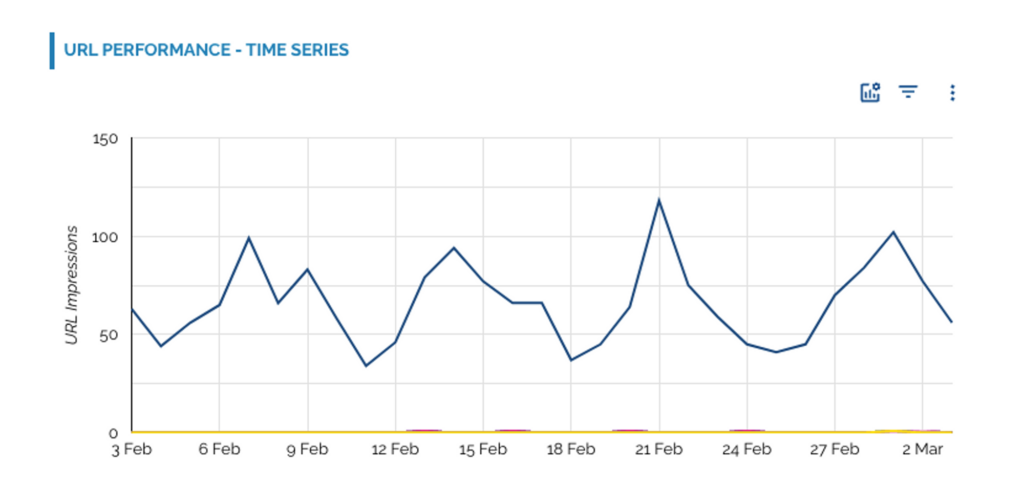
Here we have one URL that takes the majority of the traffic. All our SEO efforts are going into ranking one page, and that’s great.
But let’s look at another keyword:
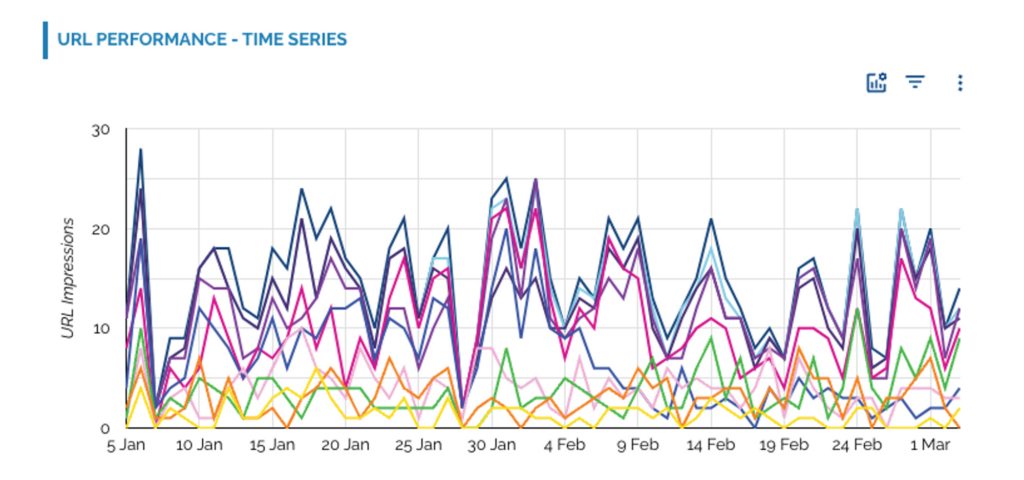
Here we have rampant keyword cannibalisation. Over ten pages are all ranking for the same keyword. This is immensely confusing for Google, and it’s hurting our chances of ranking in the top positions.
So how do you solve this?
You need to figure out which page is the most important or best place to convert this traffic. You need to then systematically link from other pages that are ranking to this page with relevant text.
This will show Google that your site thinks one of these pages is the most important resource for this keyword.
It can be really time-consuming, but after implementing this, I have seen massive boosts in traffic.
Check for opportunities
By heading to the opportunity tab and then clicking 10-20, you can see a really useful view.
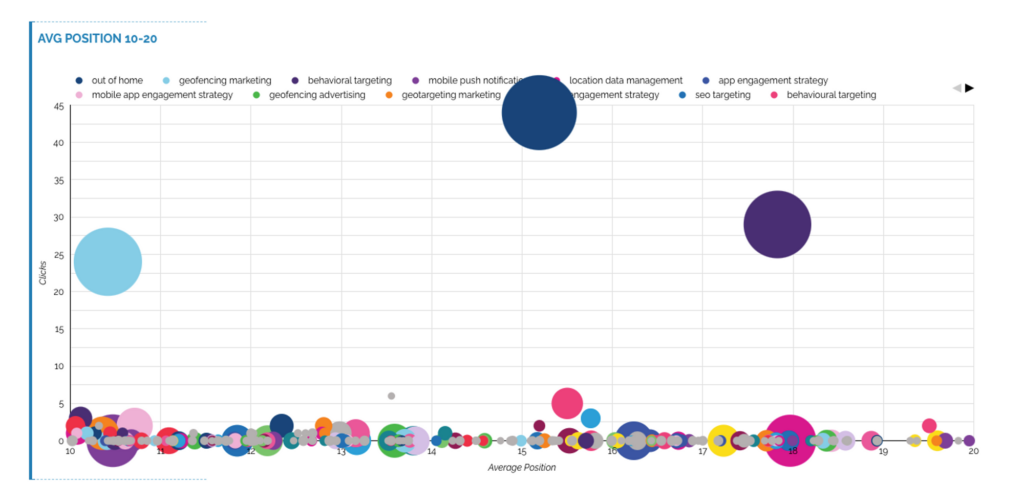
This is content that you rank on page 2 for. As we mentioned in the earlier part of this article – it’s time to optimise for these.
That might be just targeting the keyword with a new paragraph or two. Or it might require more comprehensive edits.
TIP: don’t be scared of the data when it comes to B2B SEO.
Questions are a gold mine for B2B
There’s another thing that many clients forget about – questions.
Questions are so great for both B2B and SEO. They are great because they almost always match up to a problem.
These kinds of search intent queries are perfect for B2B content, and if you can establish yourself as an authority in these niches, you can generate some great results.
You can do two things here.
See what questions you already rank for
Again we’re going to be adding filters to our Search Console reports. This time we want to look at all keywords that are beyond the first page so positions 11+.
Then we want to add a filter that only includes question terms.
This will give us all of the search queries we already rank for that are also questions.
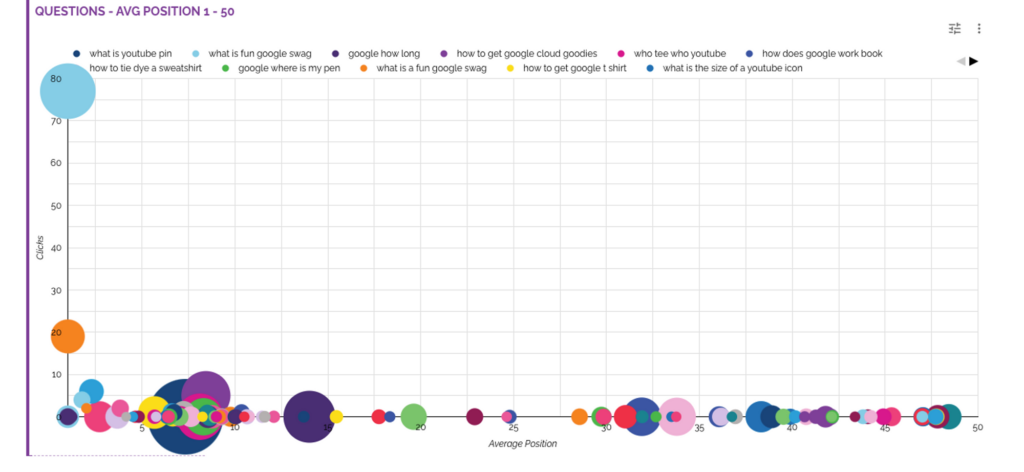
From here, it’s as simple as finding the page that ranks and updating the content to include more information on the question that people are searching for.
Find new questions to rank for
This involves a bit of research and will include the need for an SEO tool such as Ahrefs or similar.
In keyword explorer, type in a topic that you have already ranked for. This doesn’t need to be one you already rank for, but it makes it much easier if you have created topical authority already.
You’re going to want to hit the see more under questions.
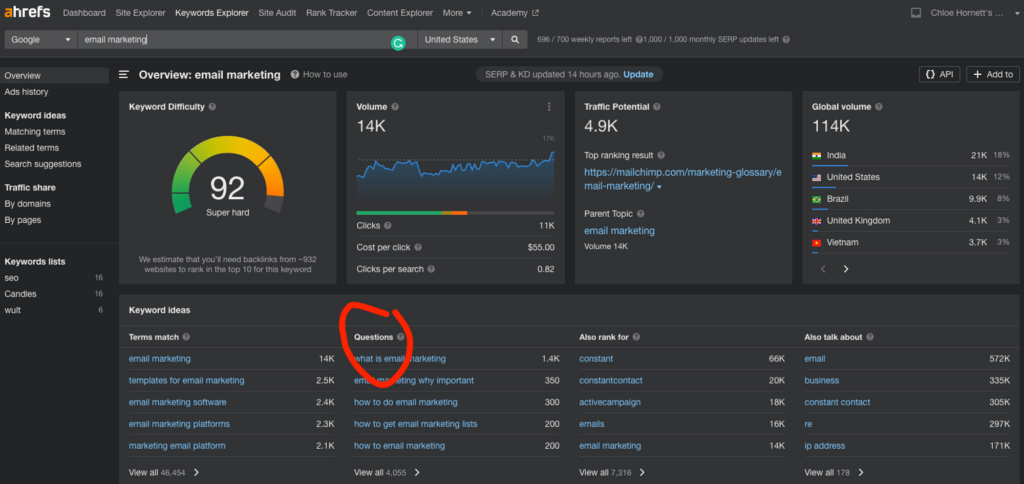
This will open a list of keywords that are questions.
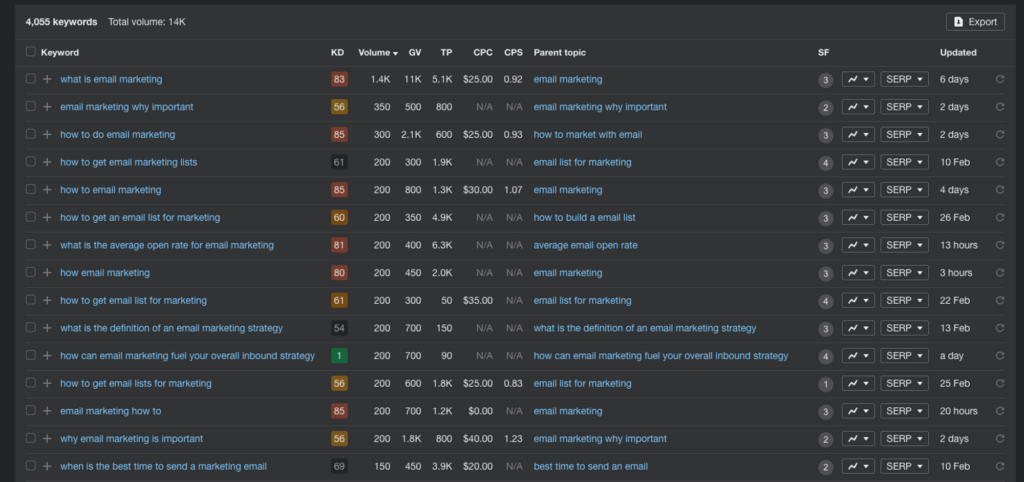
Take this and add any KD or CPC filters if you want to find it easier to rank for keywords.
Go ahead and create great content which directly answers these questions. Don’t be afraid to have a whole article answer just one of these questions.
Once it’s published, be sure to link to it internally where you can.
TIP: don’t overlook questions, as they are usually a perfect match to your B2B customer’s problems.
Build a genuine hub
Many B2B businesses understand the need to create a hub for their topics or product topics. They decide that for SEO, a specific high-level keyword is relevant, so they create a bumper blog post on that topic and they wait for it to rank.
But the problem is that this hub is just a single page.
It’s not a genuine hub.
Think about things that are considered a hub. They are rarely a single entity that solves just one problem. They are likely more of a network of interconnected items that can help to create a full understanding of what the hub is about.
The same applies when we look at B2B content and SEO.
You need to build supporting pieces alongside your main content. And you need to link to it internally and build a full hub.
When you do this, a few things happen from an SEO perspective:
- You are telling Google that this piece of content is the most important one on your site for this topic.
- You are building authority on that topic.
- You are comprehensively covering the topic.
- You are distributing link juice.
TIP: don’t just create one piece of content. Build hubs that are complimented by other content pieces to grow your search rankings.
Growth – turning that strategy from average to great
So everything you’ve seen above is going to help you build a strategy. But how do you really get to those top positions?
Let’s look at some ways that you can take what we have already discussed and turn it into a truly game-changing strategy.
How to build B2B links the right way
Now as you probably already know, links are one of the most important aspects of SEO. They are what can make the difference between ranking mid-page or reaching that top position.
So it’s imperative that you work on building links.
But wait, what if I told you that you are likely doing it wrong?
I see this so often, and it’s one of the most damaging mistakes. It also wastes a lot of budgets.
People understand that links are important to SEO. So they go and build a lot of them. They use anchor text that is exactly the same as their target keyword, and they build links right to their product page.
But guess what. Google knows that links can be doctored.
I have no way of proving this, but I’m very sure that Google implements factors into its search ranking algorithm that demotes content that is over-engineered by SEOs.
Think about it – Google wants its search results to contain the best answer to a searcher’s question or query.
So it makes sense that they would try and identify over-engineered links and limit their impact.
So what can you learn from this?
Your B2B link-building needs to be done in a smarter way.
Here are some tips:
- Avoid exact anchor text in most links. This is where you use the keyword you are trying to rank for as the anchor text in the link you are building. Try using generic anchors like ‘click here’ or branded anchors and naked URL anchors.
- As tempting as it seems, don’t link to your product page. You should build a natural link profile across your site. Think about it. In your own content, when was the last time you linked out to a product page naturally? You have to link to your content.
- Leveraging internal linking as a part of the strategy is integral. Build links across your site. Try and avoid a few pages that are getting links and instead build them to all pages on your site.
Using topical authority
Now I’ve talked about this topic extensively in this post, but it’s integral to your B2B success.
Imagine if you could rank for keywords without building links.
I know, and guess what? That’s what topical authority is about.
It’s not a simple strategy, and it can take a while to get it right.
But when it works, you can see incredible results, and it makes ranking new content much easier.
If you can establish your site as the authority on a topic, you will reap a number of benefits, from increased rankings, naturally earning links and strengthening your B2B brand.
Here are some tips on how to do it right:
- Do better research – you need to fully grasp what
- Constitutes a topic in the eyes of Google. This may require you to think in terms of entities. You need to identify every talking point and item that is covered in a topic.
- Once you have this, you need to organise these into smaller categories or clusters within the wider topic.
- Write and publish content in all of these areas. Try and tackle one sub-topic at a time as opposed to a scattergun approach.
- Build external links where necessary.
- And always remember to work on implementing internal links to your new content.
Establish yourself as a real expert
One of the things that makes B2B so appealing to SEOs is one of the reasons that it can be so difficult.
That is that you need to be seen as an authority on a topic before you can rank.
This is because the topics are usually serious stuff with high purchase prices. It wouldn’t be valuable to users to serve made-up content that isn’t well-researched in this situation.
Therefore you need to be the go-to expert on your topic. In SEO terms, we refer to this as EEAT.
This is an annoyance to say an acronym that essentially refers to how trustworthy your site is.
Here are a few examples of how you can improve this across your B2B site:
- Make sure you have included author bios on your content with relevant social profiles and bios included.
- Ensure your site is providing up-to-date advice. Outdated content might need a refresh.
- Build a better about page. Don’t just see this page as a tick-box exercise. Showcase your company’s authority on the topics you want to rank for. Don’t be afraid to include examples of works or link out to places where you are referenced.
- Work on review sites if it makes sense for you to be listed on them.
- Build links from authoritative sites in your niche.
Mistakes I see all the time in the B2B space
Okay, so we’ve covered some places you can build your B2B SEO master plan. We’ve even looked at how you can turn this plan into a complex high-reward strategy.
But what shouldn’t you do?
To be honest with you, when I’m onboarding a new client, a great deal of the time is spent undoing mistakes that they have made.
These mistakes aren’t exactly obvious, and they don’t apply to 100% of sites as each niche and SEPR is different.
But consider if they apply to you and think twice before you make them too.
Overdoing links
Links are the lifeblood of SEO. Everyone is obsessed with them. Especially sites that are new to SEO.
They understand that they are important, but they don’t realise that doing them badly can really affect your site negatively.
Google has no better way to establish authority than links. But it wasn’t to be able to protect the search results from sites that were trying to game the system.
That’s why its algorithm likely has some upper-bound SEO penalties.
In the real world, this probably translates to clearly bought or gained links.
So what we need to do as B2B SEOs is to build links in a natural way.
That can be difficult as it’s very tempting to build links to product pages and use specific anchors.
But the best practice is to do the opposite.
Keep your link % low on product pages in relation to blog content. Try and ensure that the majority of your blog posts have many links. Then add internal links back to your product pages.
And even better, use natural anchor text. Here’s a list of some:
- Click here for more information.
- Read the full article on this topic.
- Visit our homepage to learn more.
- Check out this page for further details.
- Learn more about this subject here.
- View our product selection.
- Get in touch with us today.
- See our portfolio for examples of our work.
- Find out more about our services.
- Subscribe to our newsletter for updates and news.
You can also stick to using the naked URL or your brand name. But steer away from keyword-stuffed anchor text for the majority of your links.
No expertise
B2B products will often require a high level of trust – they are complex propositions and usually cost a lot of money.
Therefore the keywords that are associated with these topics are going to require you to show yourself as a bit of an expert in the field.
That’s where EEAT comes in, and I see so many companies forget about this.
You should have a kick-ass about page, and on it, you should have content that answers one simple question:
Why should you trust us?
Don’t just answer this question there. Think author bios too.
Showing expertise will also help you to close deals and boost your conversions as well.
Going to general
Okay, so here is one mistake I see with nearly all of my clients.
They have done keyword research and identified keywords with the most monthly number of searches.
I get it. There’s something in the human condition that sees the keywords with the highest number of searches a month and thinks – hey, more traffic = good.
But the opposite can be true, especially in B2B.
B2B topics will often have a complex long-term problems attached to them.
The search intent is often not aware. It’s a problem-solving complex issue.
That’s why it makes sense to look beyond those monthly search metrics.
Sometimes the keywords with 10 searches per month will be more valuable to your B2B business.
Stop aiming for traffic as your north star SEO metric.
Too many changes at once
When working with a new client I will ask them what they have changed on the site recently. Nearly all of them have no log of changes they have made.
So how do we isolate the impact that changes to an SEO strategy have made on rankings?
It can be tempting to change a lot at the beginning of an SEO strategy.
But sometimes, it’s best to test a single hypothesis at a time.
This way, you have isolated data that you can use to measure the impact of these changes.
Scattergun approach to content
Content is so important for B2B – it’s not just essential for rankings. It helps to educate and convert the people who land on your site.
But it also carries power outside of this – by building what we call topical authority.
A mistake that I see often is no clear strategy to achieve topical authority when producing content.
Many B2B businesses take a scattergun approach to produce content, flipping between different topics in the hope that they can cover a lot of bases at once.
It’s better and more effective to pick a topic and cover the entire breadth of this topic.
Again it can be tempting to see something shiny and new, but try focusing on dominating a topic first.
This way, you will see your rankings compound as you gain links across a topic.
Technical SEO is below par.
Ah, technical SEO is something that can be so tricky.
It’s okay not to know everything about this topic or how to fix this. Heck, I don’t know everything here, not even close.
But going in completely blind can cause some big issues with your site.
Especially when it comes to things like internal linking, cannibalization and fixing indexing issues.
If you are going to have a go at this yourself, at least do it in a structured way.
Implement changes one item at a time so that you can measure the impact of these technical changes.
And make sure you get your information on what to do from a reputable source – there are a lot of chancers on the internet pretending to be experts. They will often suggest an easy and quick fix – but I have rarely found B2B SEO to be that simple.
Your B2B SEO resources
If you need to explore your search data with a little more depth than what’s available in the dashboard, then you can use a better dashboard that is built into DataStudio.
It connects instantly to your search console data, and it’s completely free.
Check it out here.
Finding competitor’s areas of success in Ahrefs
There are a few ways you can do this. After hitting a competitor domain in site explorer, you will want to check out the following pages.
Top pages

Here you will want to look at any pages that generate genuine business intent traffic.
When you find one, just click the keywords, and you will get a load of keyword suggestions.
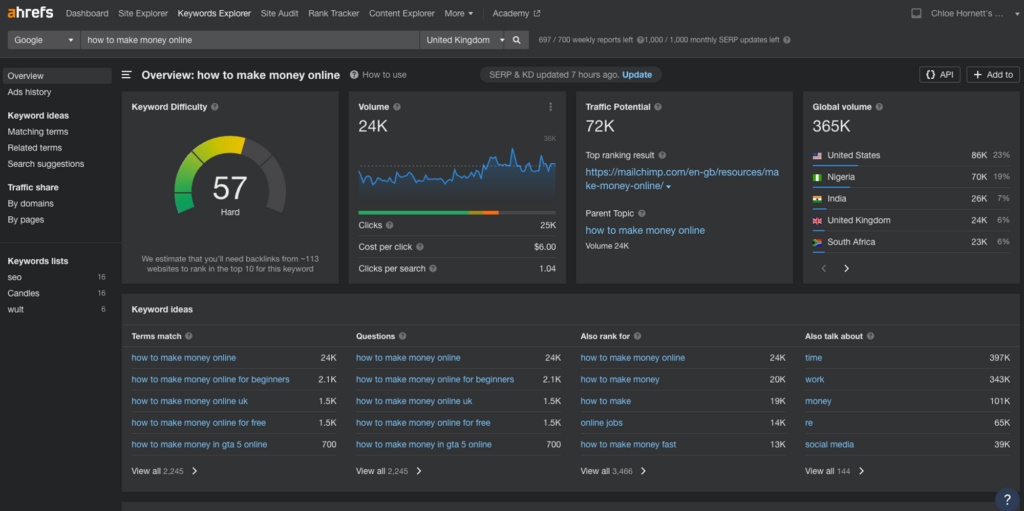
B2B SEO FAQs
If you want to know what I get asked all the time from B2B business, then here you go.




